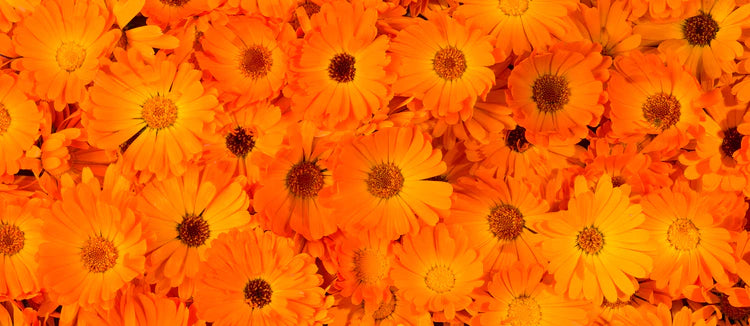hikma was born from the desire to reintroduce personal and collective rituals into your lifestyle. We understand the tradition and science of pure botanicals—and how to formulate them for a better way of living. Inspired by both knowledge and legacy, hikma’s products are expertly developed in small batches with formulations that are stripped back to the basics—allowing those all-natural ingredients to take center stage.

Calendula
Calendula officinalis
Common Name: Calendula, bride of the sun, bull flower, butterwort, common marigold, drunkard, English marigold, field marigold, garden marigold, golding, gold bloom, golds, gowlan, hen and chickens, holligold, husbandman’s dial, mally gowl, marigold, marybud, marygold, mary’s gold, poet’s marigold, poor man’s saffron, pot marigold, prophetic marigold, ringflower, ruddes, ruddles, Scotch marigold, Scottish marigold, summer’s bride, sunflower, throughout-the-months.
Family: Asteraceae/Compositae
Arabic name: اذريون
TCM Name: Jin zhan ju
Parts Used: Flower
Actions: Anti-inflammatory, Antibacterial, Anti-fungal, Antimicrobial, Antispasmodic, Antiviral, Astringent, Cholagogue, Demulcent, Diaphoretic, Emmenagogue, Hepatic, Immune tonic, Lymphatic, Vulnerary.
Taste: Bitter (mild), sweet, pungent, salty.
Energy: Warming, drying, neutral.
Native To: Calendula’s primary origin is uncertain but has been suggested as North Africa, Southern Europe, and/or the Mediterranean.
Geographic Distribution: Calendula is widely cultivated and has naturalized in temperate climates throughout the world.
Botanical Description: Calendula is a short-lived perennial that is often grown as an annual. The plant has a sticky texture due to its resin content. Calendula reaches up to 24 inches in height, its stalk supporting many branching stems and oblong leaves that are 3-6 inches long. Calendula has sunny yellow and orange flowers that open in the morning when the sun rises and close as it sets. The orange or yellow flower heads are 1-3 inches across and have a central cluster of tubular flowers surrounded by several rows of ray florets.
History and Folklore: The name calendula is a diminutive Latin form of calends (or kalends), meaning “the first day of each month” in the ancient Roman calendar, presumably because the flower was noted as blooming at that time or throughout each month; today in Italy the plant is commonly known as fiore d’ogni mese and in France as fleur de tous les mois, meaning “flower of every month.” From the 12th to the 17th centuries, calendula also appears to possess a reputation as a mood enhancer. Some editions of De Viribus Herbarum, an herbal poem by Macer Floridus (thought to be a pseudonym of the 12th-century French physician Odo de Meung), suggest calendula for cheerfulness, and propose that just gazing at the flower could draw away evil humors from the head. In the early 17th century, herbalist and botanist John Parkinson recorded that calendula was of great use among pot herbs, used in food as well as in syrup or a conserve made from fresh flowers, as a “comforter of the heart and spirits, and to expel any malignant or pestilential quality, gathered near thereunto”. Contemporary herbalist Matthew Wood also records an indication for heavy depression.
Uses: Calendula’s anti-inflammatory and astringent actions combined with its antibacterial, antiviral, and antifungal properties make it a great choice for a wide variety of skin issues. Calendula’s anti-inflammatory action goes a bit deeper than its indication for external skin and wound issues, however. According to research, the herb may also address inflammation related to bone and joint diseases. Calendula is known as "herbal sunshine" and is suited for places where "the sun doesn't shine", such as the glands under the neck, axilla, the breasts, groin and so forth. It is in fact commonly used as a lymphagogue: it cleanses the lymphatic system by moving the fluid, removing toxins from the lymph, and decongesting swollen lymph nodes. While much remains to be understood about calendula’s diverse applications, calendula’s gentle nature makes it a perfect ally for our skin.
Safety: There are a few safety concerns with calendula. It should not be used during pregnancy, as it has traditionally been used as an emmenagogue and is classed as a uterine stimulant. Calendula is a possible allergen for those sensitive to the Asteraceae plant family. While not yet studied in human trials, the herb may have potential for enhancing hypnotic or anxiolytic drugs and it has been shown—only in animal studies thus far—to increase sedative and hypotensive effects; therefore, it may potentially interact with drugs or agents with these actions as well as those with hypoglycemic or cholesterol-lowering actions. Another concern with calendula relates to its prominent use as a vulnerary; herbalists report that wounds must be fully clean before application because they have observed that the herb rapidly repairs tissue.





